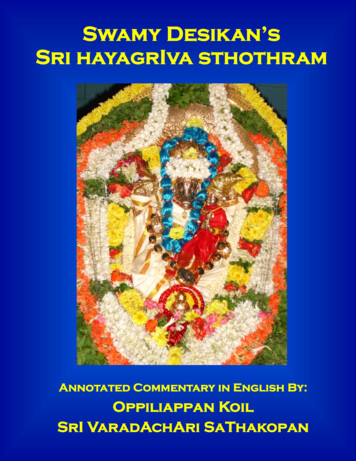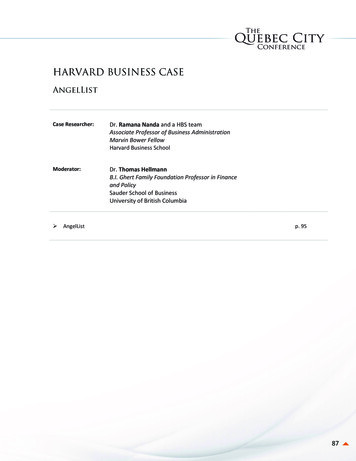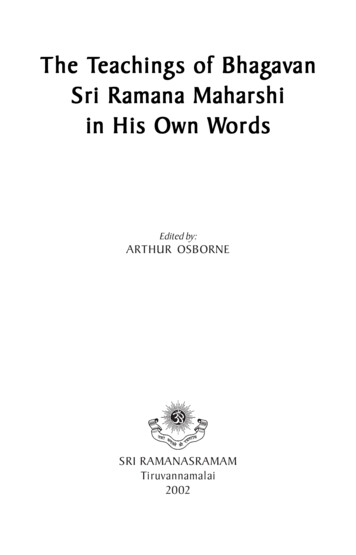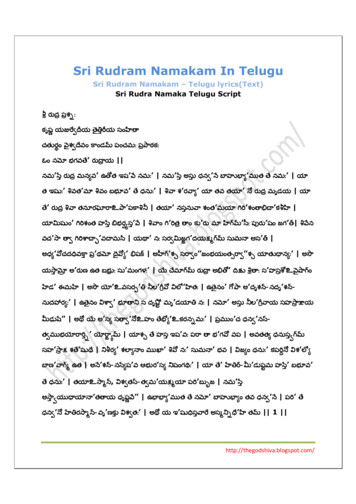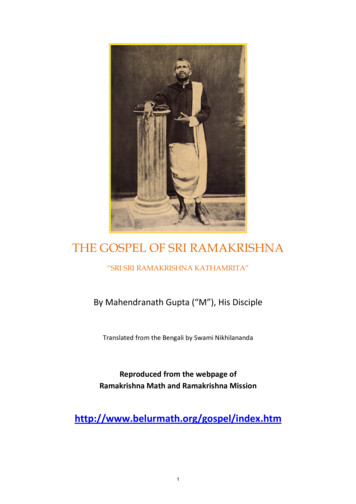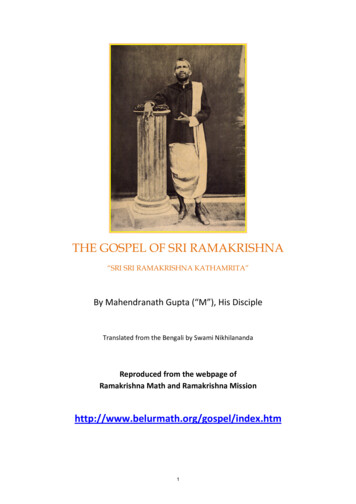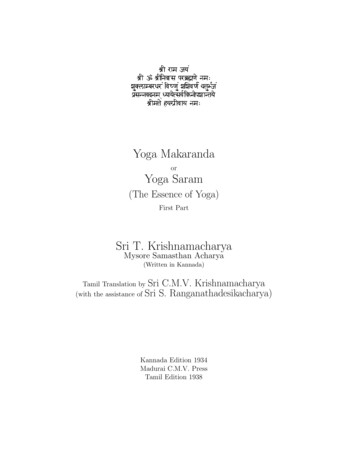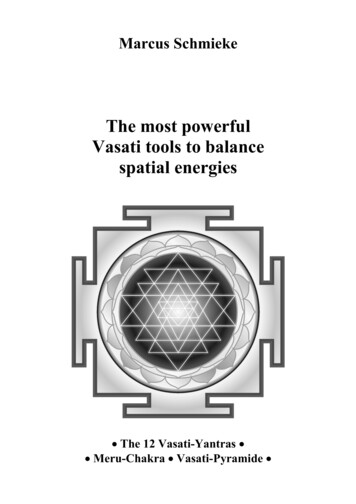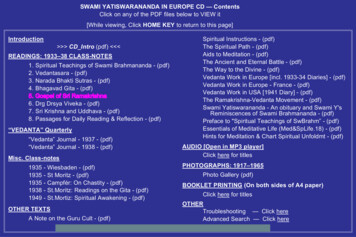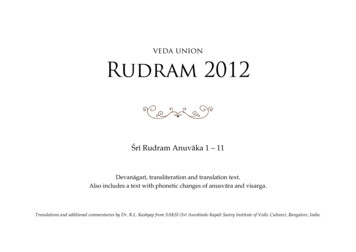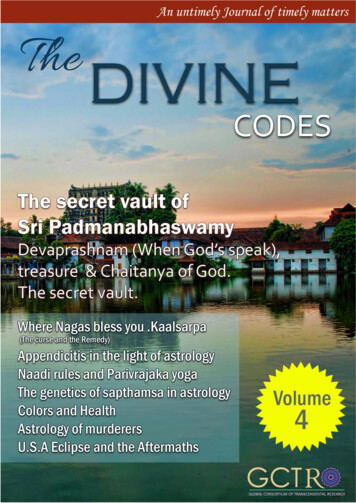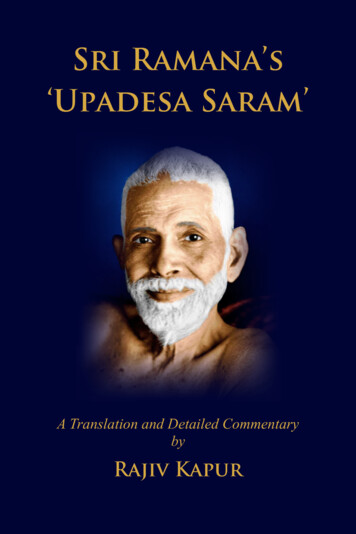
Transcription
Sri Ramana’s‘Upadesa Saram’A Translation and Detailed CommentarybyRajiv Kapur
DedicationI offer this translation of, and commentaryon the Upadesa Saram at the Lotus feet ofits author, Bhagavan Sri Ramana Maharshi,who has been my guiding light.Without Bhagavan’s blessings, I would nothave dared to present his masterpiece in thelight of my own modest understanding. Rajiv Kapur2
About the TranslatorRajiv Kapur, a householder, lives in Mumbai, India,with his lovely wife and two children.Rajiv started his inner search for the Self by beinginitiated into Kriya Yoga, which he practiced forfifteen years. After this time, however, he reached apoint where he felt he could no longer make furtherprogress. He saw that these preparatory practices,though very helpful in steadying the mind, wereexternal to the ‘I’, whereas he was keen on knowingand realizing what that ‘I’ really was.Along his journey, Rajiv met Masters and otherswho provided him with some wonderful insights
and direction, and he began to effortlessly fall into ajoyous state.Rajiv was then drawn irresistibly to the teachings ofBhagavan Sri Ramana Maharshi, who remains hisguiding light and that of his Sangha. It was at thistime that he embarked on the journey of SelfInquiry. As he turned his gaze inwards, delving deepinto the subject ‘I’, he began to spontaneouslyexperience samadhis and an ever-expanding bliss. Atfirst, the bliss lasted only for a few hours of the day,but later it became continuous and uninterrupted.He then realized that bliss is actually one’s naturalstate of being, once the ‘ego-I’ illusion is seenthrough.Since then, Rajiv has become a teacher to manyspiritual aspirants from around the world, guidingthem personally in their quest for freedom. Hissimple, direct, yet profound Implosive Self-InquiryProtocol (ISIP) not only helps practitioners stayfocused during their sitting meditation, but helpsthem to make The ISIP Technique a part of theirdaily lives through the practice of The Waking StateMeditation.4
AcknowledgementsProfound gratitude goes to Dr. Anjali Bhelande(Ph.D.) and Jo-Ann Chinn for their tireless work inhelping me in editing, proofreading and formattingthis most precious work. Without their help,encouragement and hard work I would not haveaccomplished this.I also want to thank all my students, seekers andfamily members who have inspired me, supportedme and loved me in such profound ways that hasencouraged me to share this beautiful text in thelight of their remarkable love for Truth. Rajiv5
Table of ContentsClick on the page number below to go to that section of the book.Clicking on the on each page will return you to this page.The Origin of the Text9Introduction1130 Verses of the Upadesa Saram1530 Verses in Sanskrit19Karma Yoga: The Path of Action Verses 1 to 423Verse 126Verse 231Verse 335Verse 443Bhakti Yoga: Path of Devotion Verses 5 to 1047Verse 551Verse 657Verse 761Verse 866Verse 969Verse 10726
Raja Yoga: The Royal Path of Yoga Verses 11 to 15Eight Limbs of Ashtanga Yoga78801. Yama812. Niyama853. Asana884. Pranayama895. Pratyahara916. Dharana927. Dhyana938. Samadhi94Verse 1195Verse 12100Verse 13104Verse 14106Verse 15109Jnana Yoga: The Path of Knowledge Verses 16 to 30 111Verse 16114Verse 17117Verse 18120Verse 19123Verse 20126Verse 21128Verse 22130Verse 231367
Verse 24141Verse 25146Verse 26148Verse 27151Verse 28154Verse 29157Verse 301628
The Origin of the TextAmong the various works of Sri Ramana, theUpadesa Undiyar is considered a supreme legacy,much along the lines of his Ulladu Narpudu.There is a bit of history as to how Sri Ramana cameto this text which is considered one of his bestworks apart from Ulladu Narpudu. It is said that thegreat Tamil poet, Muruganar, was once composing apoem based upon an ancient legend about a groupof ascetics who were performing various rites in theDaruka forest. These ascetics believed that Karma(path of action) is God itself. They believed that byperforming ritual austerities through their own freewill and actions, they could attain power andhappiness. Karma alone was of foremost importanceto them. They arrogantly believed that their effortsin performing Karma were bound to yield fruit andthat even Gods could not prevent their fruition. Itwas Lord Shiva who then appeared in the DarukaForest to deflate the pride of the ascetics and to offerthem the right instruction (upadesa) so that theycould all be liberated.9
As Muruganar came to the point where Lord Shivawas about to give them his spiritual teachings, hispen came to a halt. He realized that it would bewrong on his part to expound Shiva’s subtleknowledge and that only Sri Ramana, being LordShiva himself, could do justice to it. Hence,Muruganar prayed to his Sadguru, Bhagavan SriRamana, urging him to reveal the essence of theteachings which he Himself, in the form of LordShiva, had given to the ascetics of yore who wereblinded by their attachment to the path of ritualisticaction or Karma.Thereupon, Sri Ramana Maharshi composed thirtyverses in Tamil entitled Upadesa Undiyar,expounding the various paths to Liberation, all ofwhich culminate in the path of Self-Inquiry. SriRamana himself translated the work into Sanskrit asthe Upadesa Saram.In the first 15 verses, Sri Ramana has laid down thepath of selfless Karma, Bhakti and Yoga, while theremaining 15 verses (Verses 16 to 30) are devoted tothe path of Self-Inquiry.10
IntroductionEven though Self-Realization, or Atma Jnana, isattained only through the highest path of SelfInquiry, Lord Shiva knew that this sublime pathwould be beyond the scope of the ascetics due totheir current spiritual immaturity and the gross stateof their minds. Such minds needed to be refinedand made pure for them to be able to dive deeperand understand true Self-Inquiry. They had to bemade ready and hence the above three paths weregiven to prepare and purify their minds.Thus all paths, including the indirect ones like thepujas, japa, and bhakti paths of worship through apersonal God, pranayamas, etc., must be respectedand, in fact, even be embraced if need be, in orderfor the seeker’s mind to be ready for the direct pathof Self-Inquiry. Sri Ramana also offered instructionon every kind of spiritual practice for the benefit ofthose who were not yet ready to come to the directpath of Self-Inquiry. It is also well known that SriRamana gave mantras to many of his devotees and11
that one of his very close disciples was Yogi Ramaiahwho was an ardent Yoga practitioner.This proves that Sri Ramana’s approach was broadand all-encompassing. He did not advocate the pathof Self-Inquiry alone, though he did stronglyrecommend it.Therein lies Sri Ramana’s greatness. He welcomedand guided every kind of seeker, irrespective ofwhether he was a beginner or an advanced seeker,whether Yogi, Bhakta or Jnani. Even though hismain emphasis was always on the path of SelfInquiry, which is a short-cut and direct path to SelfRealization, he knew that it wasn’t an easy methodand that it required maturity of understanding. Thisis why he prescribed the three margas (paths).He clearly stated:“If, however, the aspirant is not temperamentally suitedto Vichara Marga (to the introspective analyticalmethod), he must develop bhakti (devotion) to an ideal– may it be God, Guru, humanity in general, ethicallaws, or even the idea of beauty. When one of thesetakes possession of the individual, other attachmentsgrow weaker, i.e., dispassion (vairagya) develops.12
In the absence of enquiry and devotion, the naturalsedative pranayama (breath regulation) may be tried.This is known as Yoga Marga. If an aspirant beunsuited temperamentally for the first two methodsand circumstantially (on account of age) for the thirdmethod, he must try the Karma Marga (doing gooddeeds, for example, social service). His nobler instinctsbecome more evident and he derives impersonalpleasure. His smaller self is less assertive and has achance of expanding its good side.” from talks with SriRamana Maharshi, Talk 27 - Sri MunagalaVenkataramiah.After much maturation through the preparatorymargas (Karma, Bhakti and Yoga), the path of SelfInquiry becomes naturally easy to understand in itstrue essence and the sadhaka (spiritual aspirant) isready to inquire into the Self.A Personal Note.It has been my own experience, both as a sadhakaand now as a teacher, that a blend of various paths isnecessary as the capacity of seekers differs,depending on their temperament, naturalinclination and their present level of understanding.13
Any practice, in any form, done with completededication, perseverance and devotion, will openthe doors of Self-Inquiry automatically, as happenedin my own experience. The path of Self-Inquiry thenbecomes a wonderful journey – more natural,effortless and with least interference from the mind.In closing, I believe there are two things which everyreader or aspirant desires of any text.First, it should be easy to understand and second,the reader should be able to put that understandinginto practice right away. I have tried my best tomeet both these expectations, avoiding jargon andusing as few spiritual concepts as possible.With deepest love, I offer the following translation andcommentary for the benefit of all readers,Rajiv KapurNOTE: As it is awkward to repeatedly use phrases such as ‘him orher’ and ‘he or she’, I have resorted to the traditional ‘he’, ‘him’, and‘his’ when referring to an abstract person. ‘He’ is not to be thought ofas male or female. I hope that female readers will understand the useof conventional terms and will not be offended.14
30 Verses of the Upadesa SaramClick on the number beside any verse and you’ll be takendirectly to that verse and its detailed commentary.1By the law/will of the Creator, the fruits of actions arerealized. How is action then supreme? It is not. It isinert.2The results of actions are impermanent and pass away.Yet, their seeds form an ocean of Karma whichbecomes a barrier in the progress of a seeker.3Work which is performed as an offering to theAlmighty, and done without any expectation of thefruits thereof, helps in purification of the mind andthereby leads one to Liberation or Realization.4Among the actions performed by the body, voice andmind – puja (ritualistic worship), japa (chanting) andcontemplation (inner meditation) – each is superior tothe other in an ascending order.5Worshipping any of the eight forms, thinking they areall forms of God, is good worship (puja) of God.6Singing the Lord’s praises is good, but better than thatis loud chanting of japa, while superior to loudchanting is soft japa. However, best of all is silent,mental japa.15
7Like an unbroken flow of oil, or a stream of water,continuous meditation is better than that which isinterrupted.8Meditation without duality, that is meditating as ‘I amHE’, is superior to meditation which assumes aseparation between the Bhakta (devotee) and thebeloved Lord.9A state of void, free from thought, is gradually attained,making abidance in the background state of ‘I AM’complete. This is supreme devotion.10 Fixing the mind in the Heart (Source) is true Karma(action), Bhakti (devotion), Yoga (action) and Jnana(knowledge).11 Through breath-control, the movement of the mind iscontained, just as a bird is restrained when caught in anet.12 The mind and pranas, which carry out various thoughtprocesses and actions within the body, emerge fromone common source.13 Mind control can be achieved through two modes –either through absorption/abeyance or throughcomplete destruction. In the case of the first mode, themind emerges again as it is merely absorbed in the voidand hence temporarily held in abeyance. In contrast,16
through the second mode, when the mind is destroyed,it can never emerge again.14 When the mind is held in suspension through breathcontrol, it must then be completely destroyed throughone-pointed attention to that ONE reality.15 What action remains for an exalted Yogi whose mindhas been completely destroyed and who is everestablished in the Self ?16 When attention is withdrawn from objects and focusedexclusively on the Self, Truth is revealed.17 When one inquires: “What is the mind?”, he finds outthat there is no mind. This is the direct path to Reality.18 Mind is nothing but a bundle of thoughts. Thesethoughts depend upon the I-thought alone. Hence themind is nothing but this I-thought.19 Ask the question: “From where does this I-thought arise?”On inquiring deeply, the I-thought will vanish. This isSelf-Inquiry.20 When the I-thought or Ego is destroyed, the real Isprings forth on its own in the spiritual Heart andshines as ‘I-I’, in all its fulness.21 And this unbroken continuous ‘I-I’ is the real I, as theI-thought (egoic I) disappears and dissolves in deepsleep.17
22 This real ‘I-I’ is the only Truth or Reality. Neither thebody, nor the senses, nor the vital air (prana), norbreath, nor intellect, nor ignorance may be consideredreal as they are all gross, inert, insentient and illusory.23 Is there any other thing apart from Consciousness thatillumines existence? Indeed, existence itself isConsciousness and Consciousness is ‘I AM’.24 Between the jiva (the individual) and Ishwara (Unity),there is a difference only with respect to the body andthe intellect (gross and subtle bodies), but from thestandpoint of True Nature, the Absolute Reality aloneis.25 When the various conditionings of body-mind andidentifications with name and form are shed, the Self isrealized. The vision of the Lord as Self is true SelfRealization.26 Since the Self is non-dual, establishing oneself in theSelf alone is the vision of the Self, and that alone isabidance in the Self.27 Consciousness transcends all dualities and is devoid ofthe thought of knowledge, as well as the thought ofignorance. Is there any knowledge other than SelfAwareness itself, to know the Self ?18
28 “What is the nature of ‘Me’ – the Self ?” Thus inquiringone realizes the Self as Indestructible, Unborn, Perfectand of the nature of Consciousness and bliss.29 The individual who has realized the Divine State (hisown real nature) gains supreme happiness and bliss,beyond bondage and freedom, here, in this very world.30 Self-Inquiry, devoid of ego, is a great penance. Realizethis truth articulated by Sri Ramana.30 Verses in Sanskrit1कत# रा'या )ा*य फलम् कम 0क पर2 कम त3जडम् १ 2क78त महोदधौ पतनकारणम् फलमशाAत2 ग8त8नरोधकम् २ 3ईAराEपत2 FGछया क7तम् िचKशोधकL म#िMतसाधकम् ३ 4कायवाQमनः काय म#Kमम् पSजन2 जपTUतन2 Vमात् ४ 19
5जगत ईशधीय#MतYवनम् अ[मSEतभ] वपSजनम् ५ 6उKमbतवाcGचमdदतः िचKज2 जप eयानम#Kमम् ६ 7आ3यधारया hोतसासमम् सरलिचdतन2 8वरलतः परम् ७ 8jदभावनाkसोऽहिमkयसौ भावनाऽिभदा पावनी मता ८ 9भावशSdयसnावस#िbथ8तः भावनाबलाnिMतqKमा ९ 10skbथt मनः bवbथता 8Vया भिMतयोगबोधाU 8निUतम् १० 11वाय#रोधनाvलीय मनः जालपिwवxोधसाधनम् ११ 12िचKवायविUिkVयाय#ताः शाखयोz यी शिMतमSलका १२ 13लय8वनाशF उभयरोधF लयगत2 प#नभ व8त नो म]तम् १३ 20
14)ाणबdधनाvलीनमानसम् एकTचतनाdनाश kयदः १४ 15न[मानसोkक7[यो8गनः क7kयमिbत 0क bविbथ0त यतः १५ 16द]}यवा8रत2 िचKमाkमनः िच वदश न2 तkवदश नम् १६ 17मानस2 त# 0क माग ण क7 न व मानस2 माग आज वात् १७ 18व]Kयbkवह2 - व]िKमािÄताः व]Kयो मनो 8वÅह2 मनः १८ 19अहमय2 कÇतो भव8त िचdवतः अ8य पतkयह2 8नज8वचारणम् १९ 20अहिम नाशभा3यहमह2तया bफÇर8त skbवय2 परमपSण सत् २० 21इदमह2 पदािभÑयमdवहम् अहिम लीनÖऽ*यलयसKया २१ 228वÜáिdxय)ाणधीतमः नाह कसत् त3जड2 àसत् २२ 21
23सkवभा8सका िचkMवâतरा सKया 8ह िचत् िचKया àहम् २३ 24ईशजीवयोवäषधीिभदा सkbवभावतो वbत# Öवलम् २४ 25âषहानतः bवाkमदश नम् ईशदश न2 bवाkमåपतः २५ 26आkमस2िbथ8तः bवाkमदश नम् आkम8नz यादाkम8नçता २६ 27'ानवéजताऽ'ानहीन िचत् 'ानमिbत 0क, 'ात#मdतरम् २७ 280क bवåपिमkयाkमदश F अèययाभवापSण िचkस#खम् २८ 29बdधम#Mkयतीत2 पर2 स#खम् 8वdदतीह जीवbत# द 8वकः २९ 30अहमêतकL 8नज8वभानकम् मह8दद2 तपो रमणवा8गयम् ३० 22
Karma Yoga: The Path of Action Verses 1 to 4Many people today believe that Karma Yoga is aboutperforming such actions as can bestow happinessand joy to them and their family. Many sweat it outday and night so that they can meet all the desires oftheir near and dear ones.To such people the results of their actions are moreimportant than the actions themselves and theydelude themselves into believing that theirs is thepath of Karma Yoga because they are ‘selflessly’serving their near and dear ones. They follow aritualistic pattern of work where they work tirelesslyto accumulate wealth, property and power so thatthey can satisfy every desire. They see no other Godexcept the actions they perform for the fruits theywill receive. The complete focus of their attention ison the results of their actions. They do not evenrealize how easily they fall into the trap of feelingthat they are the ‘doers’. They actually believe thatthey can bring about any result they desire throughaction, much like the ascetics of the Daruka forest23
who performed rituals believing that they couldacquire siddhis and powers. Happiness andfulfillment completely elude them as the focus oftheir attention is on profit-oriented action.Then there are others who feel that Karma Yogameans serving others. They engage in humanitarianwork, trying to alleviate other people’s suffering.It is true that Self-Inquiry cannot divorce us fromfeeling compassion for our unfortunate brethren. Infact, deep Self-Inquiry has to necessarily result in therise of compassion and love for fellow humanbeings. However, just the criterion of doing good toothers does not constitute Karma Yoga. It is not amatter of doing good acts alone, but an innermental attitude of doing one’s best to serve God andrenouncing all actions and their results to Him.The sense of ‘doership’ is very subtle and acts donewith a sense of pride, lacking humility, can give riseto ego. One must be constantly watchful not to fallinto this trap. Continuous inquiry into the sense ofdoership must be carried out. Any sense of pride orinflated self-image means ego is very much in place.24
Given our current, fast-paced, hyperactive lives, it iscrucial for us, perhaps more than ever before, tounderstand the nature of ‘right action’ and the pathof Karma Yoga.25
Verse 1कत# रा'या )ा*य फलम् कम 0क पर2 कम त3जडम् १ Karturagya praaypyate phalamKarma kim param karma tajjadamBy the law/will of the Creator, the fruits of actionsare realized. How is action then supreme?It is not. It is inert.26
Commentary:Before we can discover who the Creator is, let usfirst find out who can recognize the Creator. Is itnot Consciousness? Unless we are conscious wecannot recognize the Creator or, for that matter,anything at all.Can anything be done or created withoutConsciousness? Can we act, perform, perceive ordesire anything without the help of Consciousness?Consciousness has to be present before we can desireor create anything. Consciousness is hence theCreator. We can refer to it as God, or Ishwara, orthe Lord.If I were to ask you to point out where yourconsciousness is directed, you will say that it iseverywhere. It is limitless. But if I were to ask youspecifically where you think it originates from, youwill always point to a place within yourself. The seatof Consciousness lies within you and it is from therethat both creation and the Creator originate. So, ifthe Creator originates from within, we need to turnour attention within. Then we can surely knowHim.27
That is why Sri Ramana said that irrespective ofwhether we have free will regarding any act or not,we certainly have the will to turn inwards. Nomatter what actions take place, we can always bringour mind within. Sri Ramana always instructed thatwe direct our attention to the Self.Sri Ramana said that Consciousness, or God, gives usthe fruits of our action. This truth can easily berealized by the fact that every goal-directed actionwe perform will not necessarily bring out the resultsthat we seek for ourselves. Had it been so, then allof us would have worked with singular focus andgotten what we desired. But this is not always thecase. It is very evident that there is some other forceor power which decides what is ordained for each ofus.God or Consciousness Itself ordains what we needmost at a particular time for our inner spiritualupliftment. One must willingly and whole-heartedlyaccept even failures as they are in our best spiritualinterest and bring about our evolution. Sufferingand setbacks often become our best teachers in life,offering us an opportunity to humble our inflatedegos.28
It is prudent, therefore, to surrender the fruits ofour actions to Consciousness Itself. Our responsibilityis to simply perform the act to the best of our abilityand leave the rest to the will of God. God, or theLord, no matter what name or form you attribute toHim, is always available to us in the form of pure orstill Consciousness.The more we surrender to this power of stillConsciousness within us, the more we will realizehow potent and powerful it becomes in our lives.We will then be able to place our faith and trust inIt in all situations.We not only have no control over the fruits of ouractions, but we are also unable to select the actions.Every act that we perform is already predestined.Our past patterns of thoughts and tendencies(vasanas) create a prarabdha (that part of one’s pastKarma to be worked out in this incarnation) foreach individual body-mind.Each body-mind then simply acts according to itsprarabdha, or acquired habit, conditioned by a seriesof past events (pertaining to various past lives). Evenif you closely observe your own actions you canclearly see the reactive body-mind mechanism at29
play. We are mere instruments performing actscommanded by our past samskaras (deepimpressions carried over from previous births). Butneither the actions nor the habit-driven samskarasare true. Both are insentient and false. Only theAbsolute Consciousness, which is the source of all, istrue.For example, when we watch a show on television,there are various characters that play out their roles.Each may appear to be performing certain acts as ifhe is the one carrying out his own wish, but inactuality each is only enacting his respective role asper the instructions of the director.This ‘director’ is our past vasanas and samskaras andwe are mere actors carrying out the commands ofour inherent vasanas. But then none of the pictures,characters, actions would even appear withoutelectricity or the source of power which feeds them.Everything appears or arises due to that which, inour case, is Consciousness, or the power source. As anatural consequence, the source alone is importantand sentient. That source is manifest Ishwara orGod.30
Verse 2क78त महोदधौ पतनकारणम् फलमशाAत2 ग8त8नरोधकम् २ Krithi maho dadhau pathana kaaranamPhalam asashvatham gath nirodhakamThe results of actions are impermanent and pass away.Yet, their seeds form an ocean of Karma whichbecomes a barrier in the progress of a seeker.31
Commentary: The common man is prompted to actbecause he wants to enjoy the results of his actions.He gets lost in the midst of various activitiesthinking that they will help him acquire objects thatmake him happy. But this ocean of activities suckshim into the mire of various desires which, whenfulfilled, bring only temporary happiness, and whennot fulfilled, result in anguish and sadness. Hebecomes disillusioned as a result. Even if a particularactivity does bring about a desired result, the greedfor more never ends. Indeed, the moment a desiredobject is acquired, he loses interest in it and runsafter another, and yet another. This brings about avicious cycle of activities and desires.A mind full of desires is weak and impure. It lacksthe power to be introspective, to dive deeper and toapprehend the ultimate reality of who we really are.It is therefore clear that actions, performed with aneye on the results of such activities, will only bringabout more discontentment in life due to theimpermanent results they bring about.Actions themselves are conditioned by time, spaceand the capability of a person. Often, people feelthat if they can work tirelessly, they will be able to32
enjoy a post-retirement pension, the reward of alltheir hard work when they grow old. What happensis just the opposite. In most cases the excessiveindulgence in activities, without the innerrenunciation of the fruits, destroys mental peace andhappiness.People who are workaholics develop the disease of‘being at no-ease’ with themselves. Constantly, andoften subconsciously, they are looking for somework even if there isn’t any. They can’t stay alone,quiet and still for long. If their body finds no workthen their minds work overtime, often worryingabout many petty matters because of the acquiredhabit of constantly working at something.Often, in old age, when the body is incapable ofputting in long hours of work, such people findthemselves victims of depression and other mentalillnesses. The only remedy for such people is toplace faith in God (that inner stillness, ever presentand available), who provides us with everything weneed, rather than in actions.Effort (prayas) is laudable only when made for theright cause. The ancient Indian sages differentiatedbetween effort made for preyas, or sense-pleasures33
linked with the body-mind complex, and shreyas oreverlasting spiritual bliss. The wise aspire for thelatter, as preyas binds, bringing pain and sorrow inits wake, while shreyas liberates the sadhaka fromtime, bringing eternal joy.34
Verse 3ईAराEपत2 FGछया क7तम् िचKशोधकL म#िMतसाधकम् ३ Ishwara arpitam na icchayaa kritamChitta shodhakam mukti sadhakamWork which is performed as an offering to theAlmighty, and done without any expectation of thefruits thereof, helps in purification of the mind andthereby leads one to Liberation or Realization.35
Commentary:On reading the above two verses, a question maynaturally arise in the mind of the seeker: that if allacts are predestined, and if the result of such actsonly gives impermanent results, what is the point inperforming any action at all?The fact is that no one can remain without someform of action. Not a moment goes by withoutsome action (physical or mental). It is a veryprecarious situation. One can neither give up actionnor find everlasting happiness as a result of actions.What then is the way out?This verse clarifies this issue brilliantly and formsthe backbone of Karma Yoga as a path to SelfRealization. While the first two verses point out thelimitations of action, this verse emphasizes howaction done with the right attitude and practice canbring about Liberation. It explains the very essenceof Karma Yoga, glimpses of which are often found inthe Bhagavad Gita and the Upanishads.‘Karma’ means action. ‘Yoga’ means union. Putsimply, Karma Yoga means those actions whichresult in union with God or Self-Realization. Actions36
that are performed as offerings to the Lord are notbinding because they are done without expectationof any personal gains and with a sense of deepsurrender. Such actions become purifying as themind is now constantly engaged, not in thefulfillment of outer, carnal desires, or for egoistic selfgratification, but in pleasing God.But, who then is this God? No one has seen God. Itis obvious that to serve someone I must first knowwho I am serving. It is also obvious that He is notsomeone who is seen or known like any otherexternal object. We instinctively know that God isnot someone or something that lies outside ourselfand that He can be easily recognized within eachone of us. God seems to originate from within usand not outside of us. He can be known instantly aspeace or joy pulsating in our sense of ‘being’ (thesimple feeling that I AM without the thought ofbeing this or that). This peaceful, joyous sense ofbeing can be felt right here and now, providedthoughts are stilled.Thoughts are a hindrance and take us away fromthat inner peace and bliss which we know as God.37
Countless thoughts get triggered due to expectationsand by continuously dwelling on the results.However, if we do not focus on the results andrather pay attention only to the act (no matter howbig or small it is), then thoughts subside and therearises a natural, peaceful state (even in chaotic worksituations) which is instantly recognized as stillawareness.That still awareness is God Itself. The more we actfor the joy of the act itself, and renounce thoughtsassociated with the results arising from such acts,the more we will be able to connect to that inner joyand bliss.With good practice one will realize that no matterhow boring, unpleasant or chaotic the worksituation is, one’s attention, which was initially onthe act, now shifts to that inner bliss and stillness.Holding on to that stillness and silence amidst allactivities is true Karma Yoga – union with Godthrough action.As an advanced sadhaka (spiritual aspirant) furtherstabilizes in this state, often, he may even beoblivious of what act is taking place through him.38
His attention never wavers from that blissfulsubstratum and he may even be inattentive to actsand happenings around him. The practice that startsas an attention to an act, far transcends the act itselfin due course of practice and transforms into deepsurrender to that blissful substratum.God is not a form, name or an image. God is simplyrecognized as joyous, still awareness manifestingItself as pure Consciousness or pure I AM.An ancient story about Raja Janaka will help throwlight on the true essence of Karma Yoga. Once, abrahmin who wondered why Janaka was praised sohighly for his spiritual advancement, visited Mithila(Janaka’s kingdom). The brahmin was confused as tohow Janaka, who was a wealthy king enjoying all thepleasures that a palace can bestow, could be regardedas a great devotee and a renunciate. He appeared tobe indulging in all kinds of administrativ
verses in Tamil entitled Upadesa Undiyar, expounding the various paths to Liberation, all of which culminate in the path of Self-Inquiry. Sri Ramana himself translated the work into Sanskrit as the Upadesa Saram. In the first 15 verses, Sri Ramana has laid do
